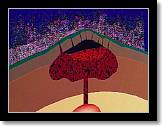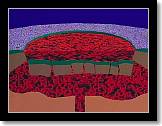
The story of Yellowstone’s thermal basins begins with features deep within the earth. At the center of the earth is the core which is surrounded by the mantle and finally the earths crust.

But what interests us is a feature known as a hotspot. It is a source of immense heat anchored within the mantle. This same hotspot is responsible for volcanic active in a number of areas in southeast Idaho including Craters of the Moon National Monument. After millions of years of movement of the earths crust this hotspot now lies beneath Yellowstone.

About 600 thousand years ago this hotspot sent a column of hot magma toward the surface forming a huge magma chamber. As the magma chamber filled it pushed upward on the earths crust forming a large dome.

As pressure built on the surface, cracks formed around the edge of the dome and a huge eruption expelled a tremendous amount of magma emptying a large portion of the magma chamber.

With the removal of hundreds of cubic miles of molten rock, the roof of the dome collapsed in what was one of the most violent explosions the earth has ever known.

Lava continued to flow into the caldera for the next 500 thousand years filling much of crater. It is this still active volcanic area that provides the heat source for Yellowstone’s thermal features.
The Yellowstone region has produced three exceedingly large volcanic eruptions in the past 2.1 million years. In each of these cataclysmic events, enormous volumes of magma erupted at the surface and into the atmosphere as mixtures of red-hot pumice, volcanic ash (small, jagged fragments of volcanic glass and rock), and gas that spread as pyroclastic (“fire-broken”) flows in all directions. Rapid withdrawal of such large volumes of magma from the subsurface then caused the ground to collapse, swallowing overlying mountains and creating broad cauldron-shaped volcanic depressions called “calderas.”

The first of these caldera-forming eruptions 2.1 million years ago created a widespread volcanic deposit known as the Huckleberry Ridge Tuff, an outcrop of which can be viewed at Golden Gate, south of Mammoth Hot Springs. This titanic event, one of the five largest individual volcanic eruptions known anywhere on the Earth, formed a caldera more than 60 miles (100 km) across.
A similar, smaller but still huge eruption occurred 1.3 million years ago. This eruption formed the Henrys Fork Caldera, located in the area of Island Park, west of Yellowstone National Park, and produced another widespread volcanic deposit called the Mesa Falls Tuff.
The region’s most recent caldera-forming eruption 640,000 years ago created the 35-mile-wide, 50-mile-long (55 by 80 km) Yellowstone Caldera. Pyroclastic flows from this eruption left thick volcanic deposits known as the Lava Creek Tuff, which can be seen in the south-facing cliffs east of Madison, where they form the north wall of the caldera. Huge volumes of volcanic ash were blasted high into the atmosphere, and deposits of this ash can still be found in places as distant from Yellowstone as Iowa, Louisiana, and California.
Each of Yellowstone’s explosive caldera-forming eruptions occurred when large volumes of “rhyolitic” magma accumulated at shallow levels in the Earth’s crust, as little as 3 miles (5 km) below the surface. This highly viscous (thick and sticky) magma, charged with dissolved gas, then moved upward, stressing the crust and generating earthquakes. As the magma neared the surface and pressure decreased, the expanding gas caused violent explosions. Eruptions of rhyolite have been responsible for forming many of the world’s calderas, such as those at Katmai National Park, Alaska, which formed in an eruption in 1912, and at Long Valley, California.
If another large caldera-forming eruption were to occur at Yellowstone, its effects would be worldwide. Thick ash deposits would bury vast areas of the United States, and injection of huge volumes of volcanic gases into the atmosphere could drastically affect global climate. Fortunately, the Yellowstone volcanic system shows no signs that it is headed toward such an eruption. The probability of a large caldera-forming eruption within the next few thousand years is exceedingly low.

One thought on “Yellowstone Caldera”
Comments are closed.